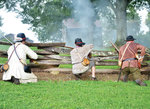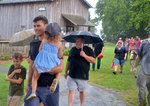






Loud gunfire and a demand for surrender were orders given to the rain-soaked defenders on the battlefield Sunday. Shots rang out, and a wagon filled with burning straw rolled towards the house that was under siege before a white flag of truce was displayed.
Temperance Alston saved her family.
The scene was a re-enactment of the Battle of the House in the Horseshoe, which occurred on July 29, 1781, when soldiers of the crown of King George III attacked the Alston House in retaliation for the death of a friend of their commanding officer.
During the battle, as bullets were flying through her home, Temperance saw a burning wagon coming towards the house. Boldly, she took out a white handkerchief and waved it about as she walked down the steps of her home to meet the enemy, David Fanning, to negotiate a truce.
Because of her actions, the battle ended, and the family of six children and their home were saved.
Last weekend saw the 238th anniversary of the historic battle at the House in the Horseshoe, which is in Moore County near Cumnock, as a crowd of spectators estimated between 1,200 to 1,500 watched the re-enactment on a rain-soaked afternoon. Re-enactors and historians came together to bring history to life.
Frank Voelker, a historic interpreter for the House in the Horseshoe historic site, raved about Ms. Alston.
“Phillip Alston owes his life to his wife Temperance,” Voelker said, “because she went out first.”
Julie Herczeg, who played the role of Temperance, is a historian with acting experience, but also in teaching the background of the period in college classes. For her, creating the role was a result of her studying of historic documents of the story, and learning a lot about the woman she portrayed.
“In order to understand history, you need to understand the psychology of the past,” Herczeg said. “It’s different from today. You need full historical context.”
Temperance’s choice, when lying in her bed and watching bullets fly through the wall, Herczeg said, was to say “Enough!” Then she did something about it. The danger to herself and her six children, and her husband, made her action necessary. In that time, if her husband had been killed in battle, she and her remaining family would most likely have lost the farm. Instead, she walked out under fire, not knowing the result of that action, to ask for a truce. It worked.
Jeremiah DeGennaro played the role of Phillip Alston, landowner, during the conflict. As such, he said he felt a responsibility to depict the gravity of the situation.
“I play the role in a way that does good service to history and the event,” DeGennaro said. “The event is serious. We show the gravity of what happened. It’s a very high emotion scenario, involving imminent danger for himself and family. If they had made different decisions, everyone could have been killed.”
His opponent in the skirmish 238 years ago was David Fanning, a loyalist, or Tory. His role was revived by Tyler Mink.
“He was intensely frustrated because Alston wasn’t coming out,” Mink said. “He wanted to solve the problem, and he outnumbered him.”
Today, Mink said, we can learn from this interpretation about protecting one’s home in the back country war of those times. This was a side conflict between Fanning, who represented the Tories, and the Whigs, or patriots, who Alston represents.
Jason Melius also played a loyalist officer, and he said he enjoys the experience as a learning tool.
“It’s one of the better events ever put on, and we make it as accurate as possible,” Melius said. “It’s a teaching experience, talking about history and how it shapes today’s events.”
Scott Douglas studies the loyalist side of the war, and helped command the attacking force in the re-enactment on Sunday.
“It’s really overlooked,” Douglas said. “I like to learn about the other side, other Americans that wanted to stay in the empire.”
The house was built in 1772, and some historic events have been lost over time, but the historians with the North Carolina Historic Sites group bring history to life at the House in the Horseshoe each year. And there is a purpose.
“It’s nice to remember what it took to win independence,” said Amanda Brantley, site manager at the House in the Horseshoe. “Wars are not just fought on battlefields; sometimes just in homes with kids in the house. It brings it home. It’s not just that simple.”
“It’s a unique experience. There’s not many places to see real Revolutionary War bullet holes you can touch,” Voelker said. “You can see the scars of the American Revolution.”
Other items that may interest you
